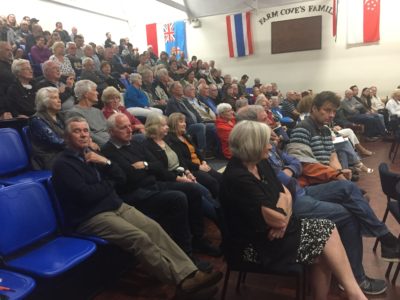
Several hundred people packed into a local school hall on a recent Monday night for a rowdy and at times heated public meeting about the impact of housing intensification in east Auckland.
The public meeting, which ran for almost two hours, was called by the Howick Residents and Ratepayers Association (HRRA) and chaired by Pakuranga MP Simeon Brown.
Among those in attendance were Howick ward councillor Sharon Stewart, HRRA chairman Matthew Brajkovich and numerous Auckland Council and Auckland Transport (AT) officials.
Howick Local Board members including chairwoman Adele White and deputy chairman John Spiller were in the audience.
Brown opened proceedings by saying it was instigated by a previous meeting over a proposed housing development that would see two homes in Venus Place, Half Moon Bay, replaced by 15 dwellings.
“I attended that meeting with approximately 50 residents of that street who are concerned about the impact such developments would have on the community,” he said.
“The concerns relate to transport, the number of cars parked on the street due to the fact the proposal only allows for one car per house and environmental concerns.
“This is one of a number of similar cases we’re seeing in the community.”
Brown said everyone agrees more houses need to be built in Auckland and quickly.
“But we also need to ensure we live in a liveable city, which is the vision of the [Auckland] Unitary Plan.
“What we are seeing in some cases is significant intensification in areas such as Venus Place that are far away from key transport links.”
He said there would be a question-and-answer session at the end and asked those gathered to be respectful of the speakers and their views.
Despite that request, numerous audience members shouted out comments or questions throughout the meeting while the council or AT officials present were speaking.
Brajkovich said the impacts of intensification across Auckland relate to traffic, flooding, property damage, fires, lack of care for the Unitary Plan’s purpose and lack of infrastructure such as sewerage and stormwater.
Council director regulatory services Craig Hobbs acknowledged intensification is a “significant issue” for the people at the public meeting.
“This is an issue that goes back probably 50, 60, 70 years, unfortunately, and there are no easy answers.
“The challenge we have is Auckland is growing at amazing rate.
“Every three years we grow by the size of Hamilton.”
He said many of the problems in the area are the result of infill housing such as “a second dwelling on a section, patios, carports and the like”.
“We believe a majority of the issues stem from that sort of development rather than intensification.”
Hobbs was followed by council official John Kennedy, who outlined the workings of Auckland’s Unitary Plan.
His presentation was frequently interrupted by angry verbal responses from the audience.
AT advisor Luke Elliott then spoke about the organisation’s delivery of public transport services in the city.
He was followed by AT senior relationship manager Ben Stallworthy, who attempted to answer people’s questions but was heckled and shouted down.
Toward the end of the meeting, the subject of land covenants in Sunnyhills was raised.
A woman in the crowd told the council officials: “I feel like you are using developers as an ATM to get money in and their developments are popping up in our community.”
Her comment was met with raucous applause from the audience.
She then said the council overrides land covenants, which she said are part of New Zealand property law.
Kennedy replied: “There are two parts to this.
“We all, including myself, only get to live where we do from developers.
“Someone comes along and creates sections. Someone is creating those titles for us.
“We have the Unitary Plan. Madam, I didn’t make up those rules.
“We have those sitting there and then if you have covenants you have conflict between those, you have to go back to court.
“That is the reality, to see what’s happening and who enforces those.”
Brown said the Unitary Plan had “painted Sunnyhills as one thing and the covenant does say another thing”.
“But John is correct. It requires, and this is the frustration of the Sunnyhills community, but it does require the people who benefit from the covenant to enforce it.”
He said the Highland Park Shopping Centre is being impacted by a legal dispute relating to a covenant.
“That is the issue we have here.
“The question we want to be asking is what are the tools we have got as a community to address these issues?
“In terms of this one, the tool unfortunately is the community has to enforce the covenant.
“That’s the answer in this case. I share your concerns.
“The positive side of it is we have a tool here. Not everywhere has a tool to use.”








